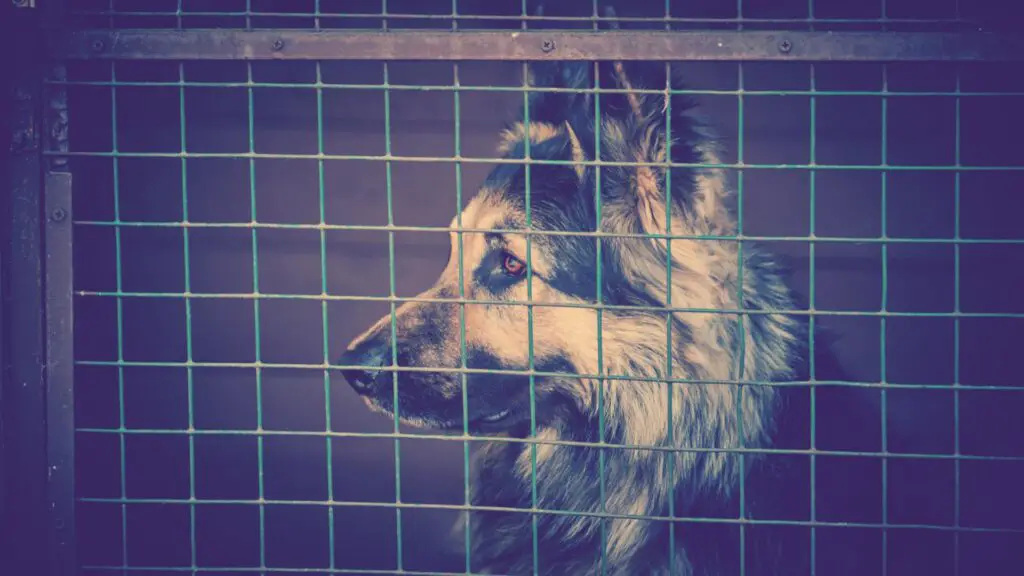The discussion of a half-German shepherd half-wolf may take you back to around 100000 years ago. It is during this duration that the divergence between the domestic dog and the wolf occurred.
Although these animals are of the same species, there is a possibility of breeding the wolves and dogs to give rise to a hybrid Wolfdog.
Other dog enthusiasts hold on to the belief that dogs separated from wolves through domestication over 15,000 years ago.
Can you imagine the breed type that will rise when a wild wolf breeds with a domesticated dog?
A beautiful example of the possible outcome is a German Shepherd Wolf Mix (half wolf half-German shepherd dog).
The German Shepherds are among the top famous and loved dogs in America, recognized for their loyalty and companionship. On the other hand, wolves are wild and mysterious.
Combining these animals through crossbreeding, you get a hybrid and legendary dog (half wolf -half German Shepherd Dog).
Another name for this breed is the Wolf Shepherd.
Are German Shepherds Part Of Wolves?
The German shepherd dogs were once referred to as the Alsatian Wolf Dog. However, the German Shepherds are not a part wolf, as you may think. But descendants of the gray wolves, which are the same family as other dogs.
In this article, we share with you as many details as possible on the breed. The information includes their history, temperament/personality, exercise, socialization, and training requirements.

Quick Facts about the Half Wolf Half German Shepherd
- The Wolf Shepherd is a powerful breed that should be handled by an experienced trainer. Therefore, this hybrid is not suited for a novice pet owner since it requires much exercise, training, and socializing.
- The wolf hybrids are yet to be recognized as an official dog breed by the American Kennel Club because they are unpredictable.
- This breed is illegal across many states.
- Nobody has succeeded in taming a wild wolf because their entire lives revolve around the wild.
History of the German shepherd Wolf Mix
As its name suggests, a half-wolf, half-German shepherd is a crossbreed between the German shepherd and a Wolf. The breed is also often called the Wolfdog or Wolf-Shepherd.
Their creation dates back to 1935 when Leendert Saarloos crossbred a Eurasian wolf with a German shepherd-Crossbreeding helped restore the natural features the German shepherd dog lost following the dog’s domestication.
Leendert gave the resultant hybrid the name Saarloos Wolfdog.
He bred this Wolfdog to maintain the natural characteristics and appearance of a wolf with the domestication of a dog.
He became successful in breeding the world’s first German Shepherd Wolf Mix and described the dog as protective, loyal, and hardworking.
Following Leendert’s success in breeding, numerous wolf mixes followed, which involved breeding other wolfdogs such as the Czechoslovakian Wolfdog, Tamaskan Dog, and the Northern Inuit Wolf Dog.
Other common types employed in the breeding process are the Czechoslovakian Wolfdog, the Kunming Wolfdog (from Chinese), and the Lupo Italiano (from Italy).
However, despite their reputation and admiration, these wolf hybrids are illegal in some states in the United States- often because American Kennel Club has not recognized the breed as the official dog breed due to their unpredictable behavior.
Therefore, before you think of keeping this breed, conduct your research to identify the states where they are allowed.
A closer look at both its parents’ breeds is vital to gain a deeper understanding of this dog’s wild and domesticated part.
The German shepherd
In your search about domestic dogs’ origin, you must have come across the name Captain Max von Stephanitz. He is recognized as the founder or creator of the German Shepherd Dogs.
With its Wolf-like resemblance, the German shepherd was created in 1899 by Captain Max von Stephanitz.
This breed gained its official recognition when Max von Stephanitz founded The Society for the German Shepherd Dog. Von Stephanitz started conducting several crossbreeding with different dog breeds.
However, the Thuringian cross show dog, which has some wolf-like appearance, was widely used in the process, which became the German Shepherd Dog breed’s original sire.
The Thuringian breed exhibited such characteristics as upright ears, long and shaggy gray hair, and a curled tail.
Therefore, much of the wolf-like appearance you observe in your contemporary German shepherd is from the Thuringian genes and not a wolf.
Furthermore, genetic tests have indicated that the Thuringian dog breed has a more direct descendant from the gray wolf.
Nevertheless, apart from the Thuringian, other dog breeds contributing to the modern German shepherds’ genetic composition include the Wurttemberg Sheep Dog and the Swabian Service Dog.
The Wurttemberg Sheep Dog role in this crossbreeding was to elevate and refocus the Thuringian’s propensity towards high energy and lack of focus. The Wurttemberg had a sturdier body structure, heavier bones, and stamina.
The breed was also more docile and easy to train.
Besides the Wurttemberg Sheep Dog, there was the introduction of the Swabian Service Dog.
This breed brought essential features into the bloodline, including huge size, courageous personality, and an even temper. These traits are unique to the modern German shepherd dogs.
Modern German Shepherds are prestigious dogs recognized as being very protective of their family and being intelligent.
Beside their intelligence and devotion towards their master/mistress, the German Shepherds are very hard working breeds.
Because of their unwavering strength and commitment to work, the GSDs are very popular with the military and the police.
However, it would be best to understand that the German shepherd is not just a working dog. The breed is very easy to train and socialize, contributing to its popularity as a family dog.
The Wolf
Wolves are wild, predatory animal breeds.
The wolves live and hunt in packs. Their lives around solely designed to thrive in the wild.
In the breeding process, two main wolf species are bred with the German shepherd dog to give rise to the half-wolf half-German shepherd:
- Eurasian Wolf
- Carpathian Wolf–which is bred with the Husky to create the Czechoslovakian Wolfdog.
Eurasian wolves are characterized by short and dense fur compared to their North American relatives.
The Eurasian wolves have different body sizes depending on their region. Typically, an adult stands at 30 inches (76 centimeters) on the shoulder and weighs 70 to 130 pounds (32 to 59 Kg).
Eurasian wolves are known to be highly social animals and may stay in packs. But due to the decline in their territory, they have compressed their numbers into smaller packs.
Despite hunting and staying in packs, wolves are very hardworking and intelligent in their conduct. They have a strong working conduct and high hunting instincts.
Also, wolves roam over large distances, they may go as far as 20 km within a day. When it comes to hunting, one wolf can catch and kill a deer without any assistance. However, if they hunt in packs, they hunt larger animals, such as deer, elk, and moose.
Vital Facts about the Wolves
- Wolves are highly unpredictable, which makes it hard to domesticate or socialize with a human-made environment.
- Being keystone species, wolves play a vital and unique role in maintaining a balance in the ecosystem. The position of keystone species on the environment in which they live is to retain the natural biodiversity. A perfect example of the keystone species is Yellowstone Park’s gray wolves.
- Wolves can sprint from 36 to 38 miles for short distances.
- Wild wolves have a lifespan of up to 13 years (in the wilderness). However, if captured and raised in protected zoos, they can live up to 16 year.
- Did you know that wolves communicate and call for pack assembling through howling? If alone, a wolf may howl to attract the attention of his pack. When they howl in packs, they are sending a territorial message to other packs nearby.
- The wolf often has his pups during spring
- Wolves are among the largest in the Canidae family
- Wolves have a gestation period of 63 days
- Grown up wolves have 42 teeth
Quick Table Comparing the Wolf and German shepherd
| German shepherd | wolf | |
| Family | Canidae | Canidae |
| Size | 22-26 inches | 36-63 inches ( head and body) |
| Weight | 50-90 pounds | 40-175 pounds |
| Teeth | 42 | 42 |
| Diet | omnivorous | carnivores |
| temperament | Loyal,intelligent,work driven | Aggressive, intelligent, cunning |
| lifespan | 12-13 years | 6-8 years ( in wild) |
| As a family pet | Yes | No |
Also Read: 6-month-old GSD puppy behavior guide.
Other Characteristics of the Half Wolf Half German shepherd
Weight and Height
The German Shepherd-Wolf mix has adapted different heights and weights.
A GSD weighs around 65-90lb (male) and 50-70lb (female) and stands nearly 24-26 inches (males) and 22-24 inches (females). On the other hand, the wolf does not have a unified breed standard and can range between 70 and 100+lb.
Therefore, depending on its sex, age, and genetics, a half-wolf half-German shepherd can weigh between 50-100lbs and a height of 20 to 26 (and above) inches tall.
Physical Appearance
As you may have observed your (or your neighbor’s) German shepherd, it typically carries a similar resemblance to that of a wolf. Therefore, the resulting hybrid should bear some of these similarities.
However, because of diversities in genetic composition, it is difficult to tell the particular features the hybrid puppy will take after maturity.
The parents are of different genres. Thus, the puppy may pick the resemblance of one parent to the other.
The German Shepherd-Wolf Mix also has a smaller skull than the wolf, pointed ears, and brown almond-shaped eyes.
Personality and Temperament
A German shepherd and a wolf have divergent traits based on their temperament and personality. So it is usually challenging to predict the characteristics the resulting hybrid will display.
However, here are some behaviors that you might look forward to from the mix:
- Wolves live and hunt in packs-this means that they are very protective and loyal to their master and will do anything to keep their family safe.
- There is a likelihood of the hybrid having a strong prey drive since both its parents are prey-driven. The GSDs are natural herders, while wolves are natural wild predators.
- The half-wolf half-German shepherd will be very shy if it takes the traits of a mother wolf. For this reason, they are not suited for guard dogs.
- The German Shepherd Wolf mix will also be unpredictable when it comes to socializing and may become aggressive. However, with lots of socializing from their puppyhood, the hybrids may be social.
Is A Half Wolf Half German Shepherd A Good Family Dog?
If your dream is to purchase this hybrid, keep in mind that this is not the best for socializing, especially with children.
The hybrid should only be kept by an experienced owner who is firm and disciplined with his puppy.
The Wolfdog will not display much of its wolf-like resemblance and behaviors until they are fully mature.
If your dream is to own this breed, then know that this is not like any other dog. There are particular laws on acquiring and raising this hybrid, which vary from one state to another.
Handling this dog breed needs experience as it can be challenging for novice dog owners.
The half-wolf, half-German shepherd is a very energetic dog that can travel up to 30 miles a day, like wolves. Therefore, the hybrid will need plenty of exercise sessions to promote its fitness and health.
The Exit
The half-wolf, half-German shepherd is not registered and recognized to breed by most Kennel clubs. Check out with the authorities if you desire to own such a dog.
Again, remember this is a breed with unpredictable temperaments.
What’s your thought regarding this topic?





